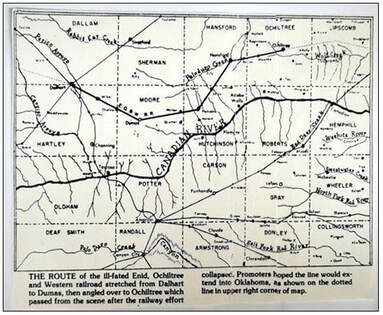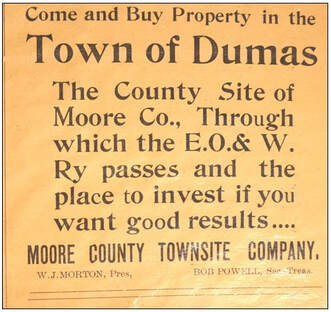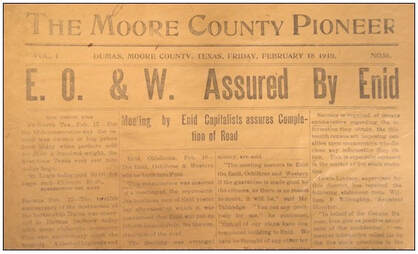20-Year Old Farmer Dreams of Railroad

In 1908, a 20-year old farmer from the Panhandle realized the need for better transportation to sell farm products and to secure supplies. He was Lynch Dodson who lived on a farm 12 miles west of Ochiltree.
Dodson envisioned a railroad that connected Ochiltree to the Fort Worth and Denver railroad in Dalhart.
According to a story in the Amarillo Sunday News-Globe in December of 1940, "Railroads were in no hurry to build into the North Plains. Despite the rapid development of the area in the early 1900's due to use of deep well drilling equipment, in 1908 a great amount of land was still under lease for livestock grazing at 3 cents per acre per year. Antelope still roamed, watering at solitary wells spaced miles apart. The county was still unfenced and stock ranged over extensive areas. Prairie dog towns stretched for miles. Indians frequented these 'flats' and buffalo were still on some of the ranches near Dalhart."
Many towns in the Panhandle, including Ochiltree, Hansford, Hutchison and Moore Counties, had no railroad links. Farmers and ranchers had to travel 60 miles or more to reach a railroad. This was a difficult task, fording the Canadian and Beaver rivers even when the weather was good. When the streams were flooded or blizzards were blowing, it became hazardous.
Dodson made a trip to Austin to consult with O. B. Colquitt, state railroad commissioner. Colquitt outlined the steps necessary to begin building a railroad.
The first step was to secure a railroad promoter. He was referred to A. E. Wiest of Indianapolis. After considerable correspondence, Wiest agreed to a trip to the Panhandle to discuss the project. Funds were needed to finance Wiest's trip from Indiana. In April of 1908, Wiest made the trip. Dodson drove a buggy and team the 50 miles to the railroad station at Glazier in Hemphill County to bring Wiest to Ochiltree.
Dodson envisioned a railroad that connected Ochiltree to the Fort Worth and Denver railroad in Dalhart.
According to a story in the Amarillo Sunday News-Globe in December of 1940, "Railroads were in no hurry to build into the North Plains. Despite the rapid development of the area in the early 1900's due to use of deep well drilling equipment, in 1908 a great amount of land was still under lease for livestock grazing at 3 cents per acre per year. Antelope still roamed, watering at solitary wells spaced miles apart. The county was still unfenced and stock ranged over extensive areas. Prairie dog towns stretched for miles. Indians frequented these 'flats' and buffalo were still on some of the ranches near Dalhart."
Many towns in the Panhandle, including Ochiltree, Hansford, Hutchison and Moore Counties, had no railroad links. Farmers and ranchers had to travel 60 miles or more to reach a railroad. This was a difficult task, fording the Canadian and Beaver rivers even when the weather was good. When the streams were flooded or blizzards were blowing, it became hazardous.
Dodson made a trip to Austin to consult with O. B. Colquitt, state railroad commissioner. Colquitt outlined the steps necessary to begin building a railroad.
The first step was to secure a railroad promoter. He was referred to A. E. Wiest of Indianapolis. After considerable correspondence, Wiest agreed to a trip to the Panhandle to discuss the project. Funds were needed to finance Wiest's trip from Indiana. In April of 1908, Wiest made the trip. Dodson drove a buggy and team the 50 miles to the railroad station at Glazier in Hemphill County to bring Wiest to Ochiltree.

The next step was to secure financing. Dodson and a neighbor, Milo Blodgett, met with County Judge George Perry. Then the discussion moved to the real estate office which Perry shared with a partner, James Whippo.
Meetings were held and Wiest sold the idea of the railroad to those who attended. He believed the railroad should be started from Dalhart, then move southeast to Dumas, then east to Hutchinson. From there he favored passing near W. J. Morton's ranch and the Lieb neighborhood, then toward Hansford, then northeast through Beaver, Wawaka and into Ochiltree.
A charter was secured from the State of Texas and a board of directors was organized. The first meeting of stockholders was held June 11, 1908. Officers elected were George M. Perry, president; W. M. McMillen, F. Dodson and R. I. Hanna, directors and A. E. Wiest, builder, vice president and general manager. Later, directors would be added from each county and included W. J. Morton of Moore County. The railroad was to be named the Enid, Ochiltree and Western Railroad.
Solicitors of stock obtained signers of stock certificates that would finance the construction.
A celebration was held September 23, 1909, to mark the formal launching of construction of the EO&W. Mayor Wagner of Dalhart drove the first spike.
The Moore County Pioneer reported in its edition of February 18, 1910, "The Enid, Ochiltree and Western railroad will be built into Enid. This consummation was assured by a meeting of the representative businessmen of Enid yesterday afternoon of which it was guaranteed that Enid will put up $50,000 immediately for the construction of the railroad."
The company office employed 17 stenographers and a chef from Denver. It was reported the railroad had the largest outlay for offices and personnel this side of Fort Worth. Whippo, who had previously worked for Fort Worth and Rio Grande railroad in Fort Worth, figured the EO&W was paying approximately four times as much per mile for construction as the Fort Worth and Rio Grande.
Directors of the company asked Whippo to get quotes from other companies who might supply engines and equipment. He found companies that could supply the needed equipment at one-half the cost.
Meetings were held and Wiest sold the idea of the railroad to those who attended. He believed the railroad should be started from Dalhart, then move southeast to Dumas, then east to Hutchinson. From there he favored passing near W. J. Morton's ranch and the Lieb neighborhood, then toward Hansford, then northeast through Beaver, Wawaka and into Ochiltree.
A charter was secured from the State of Texas and a board of directors was organized. The first meeting of stockholders was held June 11, 1908. Officers elected were George M. Perry, president; W. M. McMillen, F. Dodson and R. I. Hanna, directors and A. E. Wiest, builder, vice president and general manager. Later, directors would be added from each county and included W. J. Morton of Moore County. The railroad was to be named the Enid, Ochiltree and Western Railroad.
Solicitors of stock obtained signers of stock certificates that would finance the construction.
A celebration was held September 23, 1909, to mark the formal launching of construction of the EO&W. Mayor Wagner of Dalhart drove the first spike.
The Moore County Pioneer reported in its edition of February 18, 1910, "The Enid, Ochiltree and Western railroad will be built into Enid. This consummation was assured by a meeting of the representative businessmen of Enid yesterday afternoon of which it was guaranteed that Enid will put up $50,000 immediately for the construction of the railroad."
The company office employed 17 stenographers and a chef from Denver. It was reported the railroad had the largest outlay for offices and personnel this side of Fort Worth. Whippo, who had previously worked for Fort Worth and Rio Grande railroad in Fort Worth, figured the EO&W was paying approximately four times as much per mile for construction as the Fort Worth and Rio Grande.
Directors of the company asked Whippo to get quotes from other companies who might supply engines and equipment. He found companies that could supply the needed equipment at one-half the cost.
 1910 newspaper reports railroad plans
1910 newspaper reports railroad plans
Meanwhile, work on the railroad continued and steel was stretching closer to Dumas.
The railroad was struggling to continue building. Even the weather had turned against the project. The year of 1910 was one of drought. From January to December, total moisture was only half that of the average for the preceding 14 years. As a result, many who had signed certificates of obligation for their stock purchases were unable to make their payments. Many others refused to pay, saying the railroad had not met its obligations and put the railroad through as promised.
A sense of uneasiness was growing in the minds of the stockholders. Debts began to grow and the railroad was in serious trouble.
Finally, with steel laid 13 and seven-tenth miles from Dalhart and grading completed 44 miles toward Dumas, work came to halt.
The railroad went into the hands of receivers December 22, 1910. It was finally sold and a portion of the ties were used to build a narrow gauge spur from Arcalin, east of Liberal, Kansas, to a sand pit to secure material for paving the streets of Liberal in 1919.
In an August, 1965, story in the Moore County News-Press, Mrs. Hattie Ponder, who was county clerk at that time, remembered "as a small child seeing the mound where the land had been graded for the railroad. Coming into town from their place west of town the mound lay in a northwesterly direction from Dumas and was surrounded by grassland. Very little of the land was under cultivation then. The mound was long since been leveled and not a trace of the railroad remains."
The dream of the young Ochiltree farmer never materialized - maybe because of poor management, maybe because of the drought, maybe the wrong man was chosen to build the railroad.
The little town of Ochiltree did not survive for long. When the Santa Fe extended its lines from Darrouzett to Booker and on west into Ochiltree County, the residents of Ochiltree jacked up their homes and businesses and moved seven miles north. Residents of Gray, Oklahoma, did the same thing and moved eight miles south. Together, they formed the town of Perryton in 1919.
The little EO&W railroad that could have made commerce easier for Moore and other counties is a "Ghost Railroad." It was here, but no trace remains.
The railroad was struggling to continue building. Even the weather had turned against the project. The year of 1910 was one of drought. From January to December, total moisture was only half that of the average for the preceding 14 years. As a result, many who had signed certificates of obligation for their stock purchases were unable to make their payments. Many others refused to pay, saying the railroad had not met its obligations and put the railroad through as promised.
A sense of uneasiness was growing in the minds of the stockholders. Debts began to grow and the railroad was in serious trouble.
Finally, with steel laid 13 and seven-tenth miles from Dalhart and grading completed 44 miles toward Dumas, work came to halt.
The railroad went into the hands of receivers December 22, 1910. It was finally sold and a portion of the ties were used to build a narrow gauge spur from Arcalin, east of Liberal, Kansas, to a sand pit to secure material for paving the streets of Liberal in 1919.
In an August, 1965, story in the Moore County News-Press, Mrs. Hattie Ponder, who was county clerk at that time, remembered "as a small child seeing the mound where the land had been graded for the railroad. Coming into town from their place west of town the mound lay in a northwesterly direction from Dumas and was surrounded by grassland. Very little of the land was under cultivation then. The mound was long since been leveled and not a trace of the railroad remains."
The dream of the young Ochiltree farmer never materialized - maybe because of poor management, maybe because of the drought, maybe the wrong man was chosen to build the railroad.
The little town of Ochiltree did not survive for long. When the Santa Fe extended its lines from Darrouzett to Booker and on west into Ochiltree County, the residents of Ochiltree jacked up their homes and businesses and moved seven miles north. Residents of Gray, Oklahoma, did the same thing and moved eight miles south. Together, they formed the town of Perryton in 1919.
The little EO&W railroad that could have made commerce easier for Moore and other counties is a "Ghost Railroad." It was here, but no trace remains.